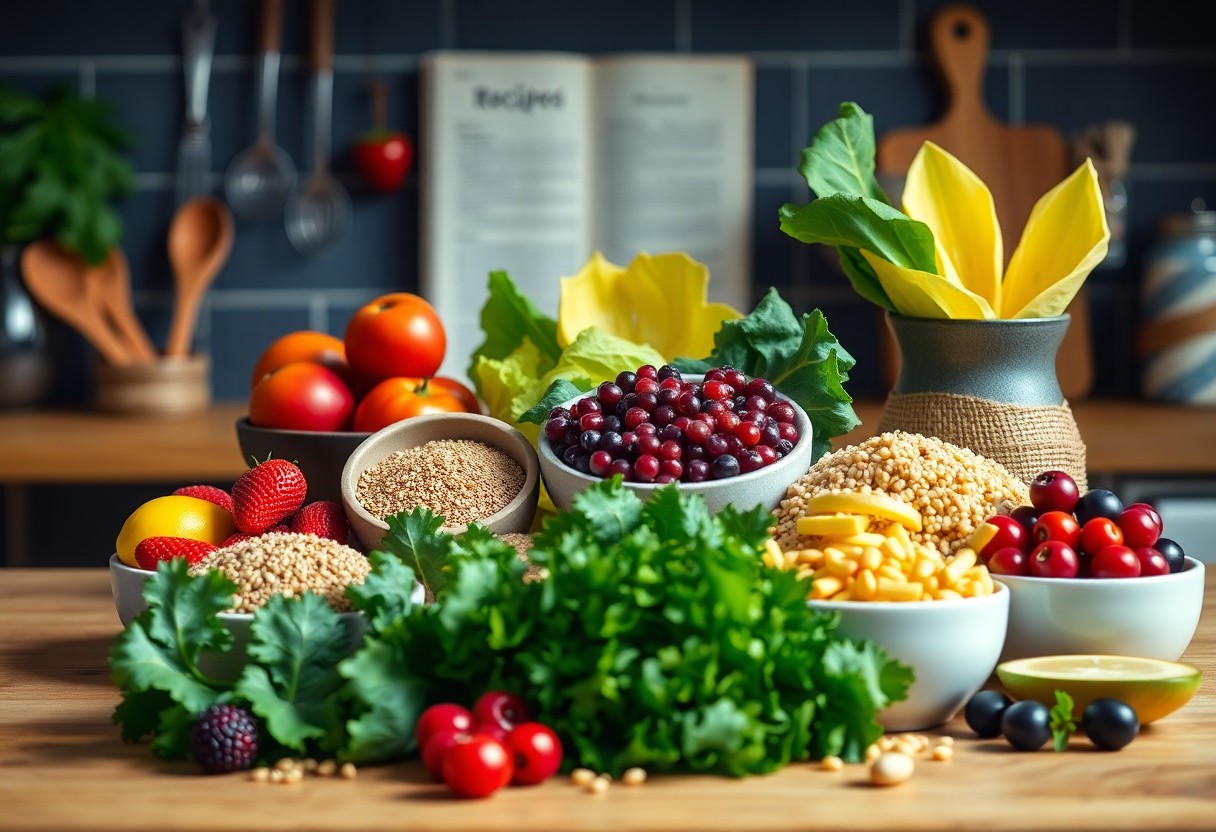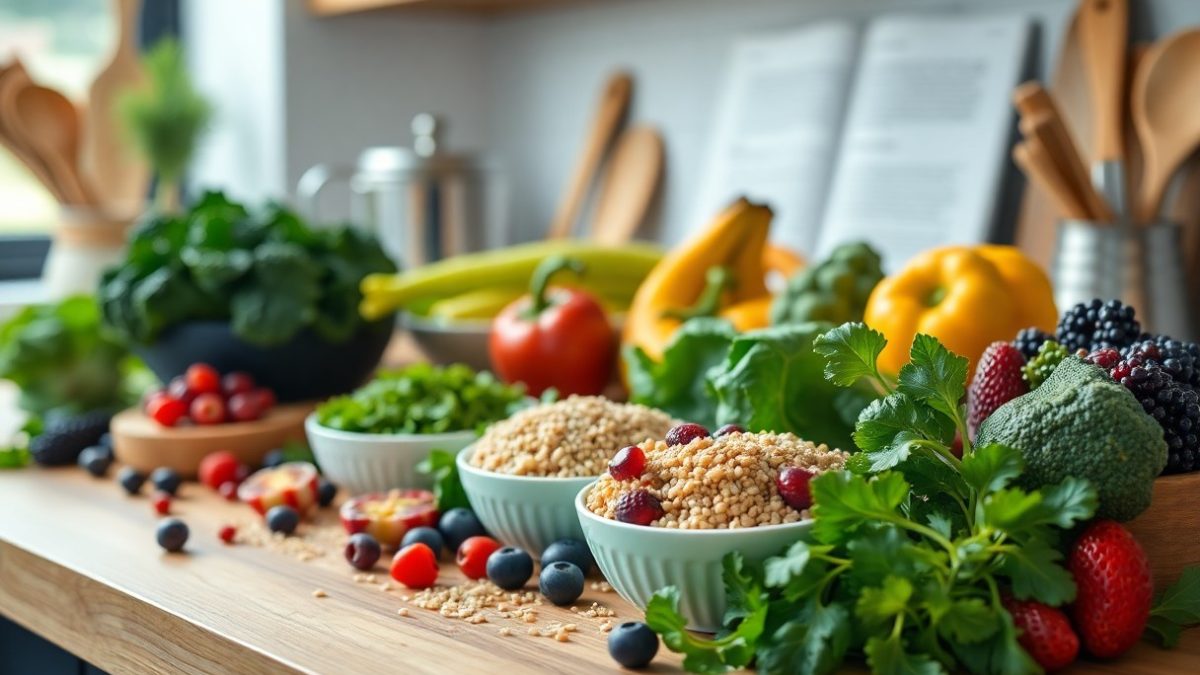Incorporating Superfoods Into Your Daily Cooking Routine

Superfoods Explained – What They Are And Why You Need Them
November 1, 2024
Family-Friendly Easy Recipes For Every Night Of The Week
November 4, 2024Routine changes can greatly enhance your health and wellness, especially when it comes to incorporating superfoods into your daily cooking. Superfoods are packed with nutrients and offer incredible health benefits, from boosting your immunity to enhancing your energy levels. By adding these powerhouse ingredients to your meals, you not only elevate the nutritional value but also introduce exciting flavors and textures. In this blog post, you’ll discover practical tips for seamlessly integrating these nutrient-dense foods into your everyday recipes, making healthy eating both easy and delicious.
Key Takeaways:
- Diverse Ingredients: Incorporating a variety of superfoods like quinoa, chia seeds, and leafy greens can enhance the nutritional value of meals.
- Strategic Pairing: Combining superfoods with everyday ingredients ensures flavorful dishes while maximizing health benefits.
- Simple Integration: Incorporate superfoods into breakfast smoothies, salads, or snacks for an easy everyday boost.
Understanding Superfoods
To truly benefit from what superfoods have to offer, it’s imperative to understand what they are. Superfoods are nutrient-dense foods that provide health benefits beyond their basic nutritional value. These foods are known to boost your body’s defenses, enhance your mood, improve heart health, and even support weight management, making them a valuable addition to your daily cooking routine.
Definition and Benefits
Behind the term “superfood” lies a category of foods rich in vitamins, minerals, and antioxidants. These foods have been linked to various health benefits, including reduced inflammation, improved digestion, and enhanced cognitive function. Incorporating superfoods into your diet can help you achieve your wellness goals and contribute to overall health.
Popular Superfoods to Consider
Any discussion about superfoods wouldn’t be complete without mentioning some of the most popular options available to you. Items such as kale, quinoa, blueberries, and avocados pack a powerful punch of nutrients that can significantly enhance your meal preparations.
In addition, consider integrating chia seeds into your smoothies for a fiber boost, or adding turmeric to your dishes for its anti-inflammatory properties. Other noteworthy superfoods include salmon for its omega-3 fatty acids, and sweet potatoes for their rich vitamins and minerals. By including these superfoods in your cooking, you’ll not only provide your body with imperative nutrients but also experiment with diverse flavors and textures in your meals.
Planning Your Meals
Any effective meal planning strategy should include a variety of superfoods to ensure you receive a wide range of nutrients. Start by mapping out your week, focusing on balanced meals that incorporate these nutrient-dense foods. By allocating time each week to plan your meals, you will find it easier to maintain consistency while enjoying the health benefits that superfoods offer.
Incorporating Superfoods into Breakfast
Your breakfast can become a powerhouse meal by adding superfoods like chia seeds, spinach, or Greek yogurt. Opt for smoothies packed with leafy greens, fruits, and nut butters for a quick and nourishing start to your day. Alternatively, consider oatmeal topped with berries and a sprinkle of flaxseeds for added fiber and omega-3s.
Healthy Lunch Options
Into your lunch routine, incorporate ingredients such as quinoa, kale, or lentils to elevate your meals. These superfoods not only provide important nutrients but also keep you feeling satiated. Combining them with lean proteins and healthy fats will result in a well-rounded and energizing meal.
Consequently, exploring healthy lunch options is an excellent way to infuse your diet with important nutrients while enjoying a variety of delicious flavors. Dishes such as a quinoa salad with cherry tomatoes, avocado, and chickpeas help boost your intake of protein and fiber, which can enhance your overall health. By choosing whole, nutrient-dense foods for lunch, you’ll sustain your energy levels throughout the day and foster a sense of well-being.

Cooking Techniques for Superfoods
Many people underestimate the impact of cooking techniques on the nutritional value of superfoods. To make the most of these nutrient-rich ingredients, consider methods that preserve their integrity, such as steaming, sautéing, or quick roasting. Avoid techniques that expose them to prolonged heat or high temperatures, which can diminish their beneficial compounds. By using the right cooking practices, you can enhance the flavors of superfoods while maximizing their health benefits.
Best Practices for Preserving Nutrients
About 80% of nutrients in superfoods can be lost during cooking if not handled properly. To preserve their goodness, try to cook them at lower temperatures and for shorter periods. Using minimal water and opting for methods like blanching or sautéing over boiling will retain more vitamins and minerals. Always avoid overcooking, as this can significantly reduce their nutrient content.
Quick and Easy Cooking Methods
Before submerging into meal prep, consider how quick and easy cooking methods can simplify incorporating superfoods into your diet. Streamlining your approach can help you maximize nutrient absorption while minimizing prep and cook times.
Quick cooking techniques such as microwaving, steaming, and blanching can save you time in the kitchen while still preserving the crucial nutrients in superfoods. For example, microwaving greens like spinach or kale for a short duration can maintain their vibrant color and nutrient density. Similarly, steaming vegetables locks in flavors and nutrients more effectively compared to boiling. By prioritizing these easy cooking methods, you can enjoy the benefits of superfoods without lengthy preparation, making it easier to enjoy healthy meals every day.
Creative Superfood Recipes
Once again, it’s time to explore inventive ways to incorporate superfoods into your meals. With endless possibilities, you can transform everyday dishes into nutrient-packed delights. Whether you’re in the mood for a hearty breakfast, a refreshing snack, or a colorful dinner, discovering new recipes will keep your taste buds excited while boosting your overall health. The versatility of ingredients like quinoa, kale, chia seeds, and spirulina opens the door to a world of delicious culinary creations that you can easily integrate into your daily routine.
Smoothies and Juices
Before exploring into smoothies and juices, you should know that these beverages are a fantastic way to pack in multiple superfoods effortlessly. Blend leafy greens like spinach or kale with fruits such as bananas and berries, and add a tablespoon of nut butter or seeds for a protein boost. The addition of spirulina or acai powder not only enhances flavor but also amplifies the health benefits, making your drink both nutritious and refreshing.
Salads and Snacks
Recipes featuring superfoods can make your salads and snacks both vibrant and nutritious. Incorporating ingredients like quinoa, walnuts, or goji berries into your salads can elevate your meals, while superfood energy bites or raw snacks packed with chia seeds and oats serve as guilt-free treats. Adding a variety of colors and textures will keep your palate intrigued while ensuring you consume a wide range of nutrients.
Even simple changes to your salad and snack recipes can yield significant benefits. By introducing ingredients like kale, known for its high vitamin K and antioxidant content, or hemp seeds, rich in omega-3 fatty acids, you enhance the nutritional profile of your meals. Don’t shy away from using colorful fruits like pomegranates or avocado in your salads, as they can contribute healthy fats and a burst of flavor. Whipping up snacks like energy balls with ingredients such as cacao can provide a delightful treat while keeping your energy levels high throughout the day.
Superfood Storage and Freshness
Your approach to superfood storage can make a significant difference in maintaining their freshness and efficacy. For detailed guidance on incorporating these nutrients into your daily routine, check out How to Incorporate Superfoods into Your Daily Diet.
Tips for Keeping Superfoods Fresh
Superfoods can lose their potency if not stored correctly. Here are some tips to ensure they stay fresh:
- Keep nuts and seeds in airtight containers.
- Store berries in the fridge to avoid spoilage.
- Utilize dark glass containers to protect from light.
Knowing how to store your superfoods can enhance their longevity and nutritional benefits.
Best Storage Practices
Best practices for storing superfoods revolve around temperature and moisture control. Most superfoods like chia seeds, goji berries, and spirulina thrive in a cool, dark place. Always check the packaging for specific storage instructions, as some may require refrigeration after opening. Avoid humidity, as it can lead to mold growth and spoilage. You can also freeze certain superfoods for longer shelf life. Ensuring the right environment for your superfoods helps maximize their nutritional value and aroma.
Overcoming Challenges
Now that you understand the benefits of incorporating superfoods into your cooking routine, you may face some challenges. From budgeting constraints to taste preferences, navigating these obstacles is necessary for successfully integrating these nutrient-dense foods into your meals. With a little creativity and a willingness to try new things, you can easily overcome these hurdles and enjoy the health benefits superfoods have to offer.
Budget-Friendly Superfood Choices
With the right strategies, you can find superfoods that fit your budget. Focus on staples like beans, lentils, and seasonal vegetables that provide necessary nutrients without breaking the bank. Additionally, buying in bulk or opting for store brands can make a significant difference in your grocery bill while still allowing you to enjoy a variety of superfood options.
Addressing Taste Preferences
Challenges arise when trying to incorporate superfoods into your meals if you or your family have specific taste preferences. It can be difficult to introduce new flavors without resistance, and you may find yourself catering to the tastes of others.
It is important to gradually introduce superfoods into your dishes, starting with small amounts and combinations that are more familiar to you. Experimenting with different cooking methods, seasonings, and pairings can help you discover ways to enhance the flavor of superfoods, making them more appealing. For instance, adding berries to smoothies or blending leafy greens into sauces can mask their taste while still providing their health benefits. Keep an open mind, and involve your family in the cooking process; they may surprise you by enjoying these nutrient-rich ingredients.
To Wrap Up
Considering all points, incorporating superfoods into your daily cooking routine is a simple yet impactful way to enhance your nutrition. By gradually introducing these nutrient-dense ingredients into your meals, you can boost your overall health and well-being. Experiment with different superfoods, explore new recipes, and find what works best for you. With a little creativity and effort, you can make superfoods a delightful part of your culinary journey and enjoy the numerous benefits they offer.
Q: What are superfoods and how can they benefit my health?
A: Superfoods are nutrient-rich foods that are considered to be especially beneficial for health and well-being. They are typically high in antioxidants, vitamins, minerals, and healthy fats. Incorporating superfoods into your daily cooking routine can help improve your overall nutrition, boost your immune system, and reduce the risk of chronic illnesses. Some popular superfoods include berries, leafy greens, nuts, seeds, and quinoa, all of which can easily be added to meals for enhanced flavor and nutritional value.
Q: How can I start including superfoods in my daily meals without overwhelming myself?
A: Start by choosing a few superfoods that you enjoy and gradually incorporate them into your meals. For example, you might add spinach to your morning smoothies, sprinkle chia seeds on your yogurt, or use quinoa as a base for salads and grain bowls. Meal prepping can also help, as you can prepare dishes in batches that include a variety of superfoods, making it easier to incorporate them into your diet consistently without extra daily effort.
Q: Are there any easy recipes I can try that feature superfoods?
A: Absolutely! Here are a couple of easy recipes:
1. *Berry Smoothie Bowl*: Blend your favorite berries with spinach or kale, add a banana for sweetness, and top with granola, sliced fruits, and chia seeds.
2. *Quinoa Salad*: Combine cooked quinoa with black beans, diced bell peppers, corn, avocado, and a lime vinaigrette. This dish is packed with protein and fiber and can be customized with any vegetables you love. Both recipes are not only delicious but also simple to prepare and packed with nutrients!
NEWSLETTER







